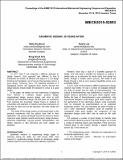Axiomatic Design: 30 Years After
Author(s)
Nordlund, Mats; Lee, Taesik; Kim, Sang-Gook
DownloadKim_Axiomatic design.pdf (1.931Mb)
PUBLISHER_POLICY
Publisher Policy
Article is made available in accordance with the publisher's policy and may be subject to US copyright law. Please refer to the publisher's site for terms of use.
Terms of use
Metadata
Show full item recordAbstract
In 1977, Nam P Suh proposed a different approach to design research. Suh’s approach was different in that it introduced the notions of domains and layers in a 2-D design thinking and stipulated a set of axioms that describes what is a good design. Following Suh’s 2-D reasoning structure in a zigzagging manner and applying these axioms through the design process should enable the designer to arrive at a good design.
In this paper, we present our own experiences in applying Suh’s theories to software design, product design, organizational design, process design, and more in both academic and industrial settings. We also share our experience from teaching the Axiomatic Design theory to students at universities and engineers in industry, and draw conclusions on how best to teach and use this approach, and what results one can expect.
The merits of the design axioms are discussed based on the practical experiences that the authors have had in their application. The process developed around the axioms to derive maximum value (solution neutral environment, design domains, what-how relationship, zig-zag process, decomposition, and design matrices) is also discussed and some updates are proposed.
Date issued
2015-11Department
Massachusetts Institute of Technology. Department of Mechanical EngineeringJournal
Proceedings of the ASME 2015 International Mechanical Engineering Congress and Exposition
Publisher
ASME International
Citation
Nordlund, Mats, Taesik Lee, and Sang-Gook Kim. “Axiomatic Design: 30 Years After.” ASME, 2015. V015T19A009. © 2015 by ASME
Version: Final published version
ISBN
978-0-7918-5758-8